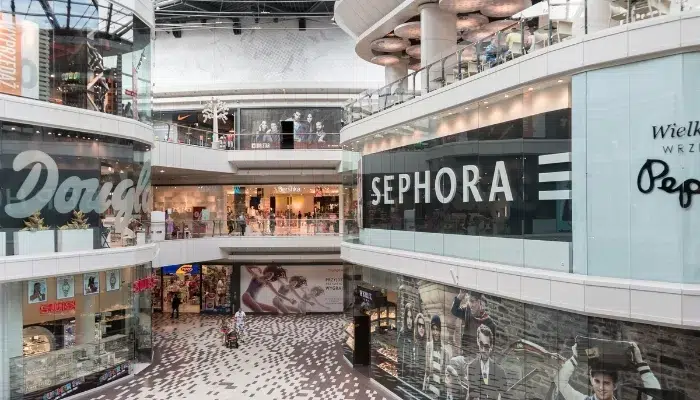Brand Strategy
Curious About Luxury Retail? Explore How Location Can Make or Break a Brand

- The U.S. luxury retail market surged to over $75 billion in 2023, with brands seeking prime locations in high-end malls and exclusive areas to expand their presence.
- Strategic leasing is essential for luxury brands, focusing on customer experience, brand alignment, and adaptability to changing market conditions.
- Developers and property owners can attract high-end tenants by creating immersive shopping environments and leveraging technology to engage the next generation of luxury consumers.
In the realm of luxury shopping, the age-old adage “location, location, location” is more relevant than ever. As the luxury industry grows, with U.S. sales topping $75 billion in 2023—a phenomenal 8.9% increase over the previous year, according to the most recent JLL Luxury Report—brands compete for prominent retail locations. From the illustrious halls of New York’s Madison Avenue to the gorgeous Beverly Hills Triangle, luxury is not only returning but growing in exciting new ways.
However, in a highly competitive market where great retail space is scarce, how can property owners attract and maintain high-end tenants? The answer is strategic leasing, an innovative technique that combines luxury businesses’ aims with the distinct characteristics of their retail venues.
Creating Luxury Destinations
Despite inflationary pressures, the luxury market in the United States is rapidly expanding, as indicated by luxury businesses leasing more than 360,000 square feet of retail space between July 2023 and July 2024. Almost half of these new luxury outlets have opened in premium malls, with major additions such as Gucci’s 17,500-square-foot boutique at Costa Mesa’s South Coast Plaza and Valentino’s large 25,000-square-foot store on Madison Avenue.
To remain competitive, property owners must rebrand their assets as premium destinations that stand out from mass-market competitors. This can be accomplished through private addresses, designated “luxury wings” in upmarket malls, and other distinct zones inside shopping centres. These techniques provide a clear message: these luxury brands represent superior quality and status that cannot be obtained elsewhere.
Expanding Physical Footprints
While e-commerce has gained a large part of retail sales—16% in Q2 2024—physical stores continue to play an important role, with more than 80% of retail sales still taking place in-store. Recognising this, premium businesses are eager to increase their physical presence. Many customers prefer flagship stores that offer one-of-a-kind, premium shopping experiences. The question remains: as demand for premium retail space rises, how can property owners support this growth?
Malls provide a significant advantage by allowing property owners to reallocate smaller tenants and make room for luxury brands to develop flagship stores in excellent locations. This method not only attracts high-end tenants but also improves the general appeal of the retail mall.
Catering to The Next Generation of Shoppers
As Gen Z and younger consumers are expected to account for 70% of global luxury expenditure by 2030, retail leasing tactics must develop accordingly. This group desires more than simply items; they want exclusivity, personalisation, and immersive experiences.
Property owners can work with their management teams to help luxury tenants create compelling pop-up experiences or influencer-driven events that appeal to this younger audience. Malls and luxury shopping centres may strengthen their relationships with the next generation of luxury buyers by creatively integrating lease methods and merchandising solutions.
Positioning for Long-term Success
The luxury retail industry shows no signs of slowing. Property owners can take advantage of this increase by implementing strategic leasing procedures. This includes acquiring high-end tenants, revamping existing venues, and developing experiences tailored to today’s luxury consumers.
A deliberate approach, whether it is expanding flagship stores or merging hotel and retail, will secure long-term asset value and position properties as prime destinations in an increasingly competitive luxury market.
Understanding Strategic Leasing
At its foundation, strategic leasing is a proactive approach to real estate management that aligns a premium brand’s physical presence with its overall business goals. It goes beyond traditional lease discussions, becoming a strategic instrument for driving growth, improving brand image, and optimising operating efficiency.
Key Principles of Strategic Leasing
- Location Matters: Strategic leasing emphasises the value of prime locations. A thorough examination of retail corridors and burgeoning communities aids in the identification of locations that appeal to the brand’s intended audience.
- Customer-Centric Focus: Understanding consumer behaviour is critical. By evaluating preferences and demographics, marketers may select locations that provide a consistent shopping experience.
- Brand Alignment: The location should suit the brand’s identity, values, and messaging to provide an immersive customer experience.
- Flexibility and adaptability: The retail scene is constantly changing. Strategic leasing enables brands to adapt by offering flexible lease periods and expansion options.
- Cost Optimisation: While premium locations are costly, strategic leasing maximises return on investment by taking into account foot traffic, lease rates, and operating costs.
Benefits of Strategic Leasing
- Enhanced Brand Image: Having a presence in prestigious areas improves a brand’s perception.
- Increased Sales: Aligning with client preferences increases foot traffic, which boosts sales and profits.
- Improved consumer Experience: Focussing on delivering immersive experiences encourages consumer loyalty.
- Operational Efficiency: Optimising location and lease terms lower operating costs.
- Competitive Advantage: Securing prime locations before they become inaccessible provides a major advantage over competitors.
Case Studies in Action
- Gucci’s Global Expansion: Gucci‘s strategic leasing has permitted its global expansion, with new stores opening in both emerging regions and classic sites, with an emphasis on experiential retail.
- Hermès flagship stores: Hermès’ flagship stores, known for their architectural brilliance, help to enhance the brand’s luxury image.
- Louis Vuitton’s Pop-Up Stores: Louis Vuitton uses pop-up stores to test new markets and engage niche consumers, creating a sense of exclusivity.
The Future of Strategic Leasing
As the retail landscape evolves, smart leasing will become increasingly important for premium businesses. The integration of technology, data analytics, and new trends will improve leasing strategies, allowing firms to make more informed decisions and provide better customer experiences.
Conclusion
To summarise, strategic leasing is more than just getting good sites; it is about creating a strategic advantage that promotes growth and provides excellent customer experiences. Understanding the principles and benefits of strategic leasing allows luxury companies to traverse the complexity of the retail landscape and position themselves as leaders in an increasingly competitive industry.
In today’s world of luxury retail, the correct leasing strategy may transform spaces into sought-after hotspots that appeal to discerning customers.

















































